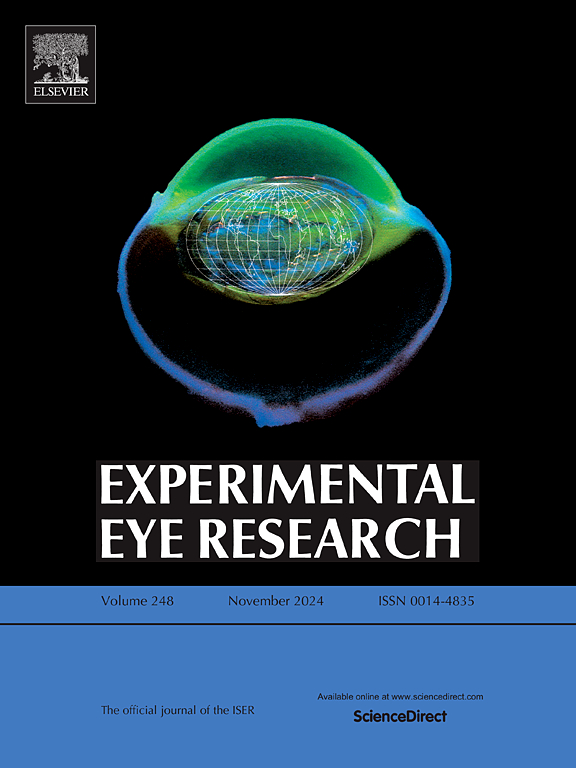Genetic association of MIR-449B, GCLC, eNOS, SORD, and ENPP1 with diabetic retinopathy
IF 3
2区 医学
Q1 OPHTHALMOLOGY
引用次数: 0
Abstract
Identifying the genetic risk factors of diabetic retinopathy (DR) is essential for discovering the potential pathogenesis of DR. This study determined the association of DR with five single nucleotide polymorphisms (SNPs) specifically in type 2 diabetes mellitus (T2DM) patients, including rs10061133(MIR-449B), rs17883901(GCLC), rs2070744(eNOS), rs3759890 (SORD) and rs7754561 (ENPP1). A total of 1433 individuals were enrolled in this study, comprising healthy controls (ctrls = 480), individuals with diabetes mellitus without retinopathy (DNR = 480), non-proliferative DR(NPDR = 378), and proliferative DR(PDR = 95). The five SNPs were genotyped utilizing Mass ARRAY MALDI-TOF technology. Odds ratio (OR) and 95% confidence intervals (95% CI) were calculated for the risk of genotype and allele. We performed a literature search in PubMed published before July 16, 2023. The Newcastle Ottawa Scale was used to evaluate the overall quality of the case-control studies. Consequently, we found that there were statistically significant differences between PDR cases and healthy controls for rs10061133 (P = 0.007, OR = 1.59, 95% CI = 1.32–2.23) and rs17883901 (P = 0.020, OR = 1.67, 95% CI = 1.08–2.57), rs17883901 was significantly associated with NPDR (P = 0.023, OR = 1.39, 95% CI = 1.05–1.85), there was a significant association between DR cases and healthy controls (P = 0.048, OR = 1.22, 95% CI = 1.00–1.48) for rs3759890 in the allelic model. DR show no relationships with the other two SNPs compared to healthy controls. In multivariate analyses comparing the DR and DNR groups, rs7754561(A), rs10061133(G), and rs17883901(A) were identified as risk loci for DR in individuals with a duration of diabetes of ≥5 years (P = 0.0023, P = 0.0037, and P = 0.0376, respectively). Furthermore, individuals carrying rs10061133(G) exhibited a higher risk of DR in the hyperglycemic group (glucose ≥8 mmol/L). Secondly, we showed that one polymorphism in eNOS (rs2070744, T > C) showed a suggestive association with DR in the meta-analysis (allelic model:P < 0.05, OR = 1.18, 95% CI: 1.07–1.30, Z = 3.46, I2 = 34%). Subsequently, including studies that used either healthy subjects or diabetic subjects without DR as controls, the association of eNOS rs2070744 with DR was consistently significant (P = 0.002) and exhibited intermediate heterogeneity (I2 = 48%). Furthermore, polymorphisms in GCLC (rs17883901) and SORD (rs3759890) were also associated with DR, with P-values of 0.004 (I2 = 93%) and 0.03 (I2 = 3%), respectively, suggesting their potential involvement in the disease. In conclusion, this study documented that rs10061133(G), rs17883901(A), and rs3759890(G) could be the independent risk factors for retinopathy in Chinese patients with T2DM, offering a foundation for genetic risk assessment in clinical practice. Furthermore, our meta-analysis reveals a significant association between rs2070744 and DR, implying the potential involvement of the MIR-449B, GCLC, SORD, and eNOS variants in the development of DR, which could be a promising direction for developing new treatments aimed at mitigating the risk of DR in susceptible populations.
MIR-449B、GCLC、eNOS、SORD和ENPP1与糖尿病视网膜病变的遗传关联
确定糖尿病视网膜病变(DR)的遗传危险因素对于发现DR的潜在发病机制至关重要。本研究确定了2型糖尿病(T2DM)患者特异性的5个单核苷酸多态性(snp)与DR的关联,包括rs10061133(MIR-449B)、rs17883901(GCLC)、rs2070744(eNOS)、rs3759890 (SORD)和rs7754561 (ENPP1)。本研究共纳入1433名受试者,包括健康对照(对照组=480)、无视网膜病变的糖尿病患者(DNR=480)、非增殖性DR(NPDR=378)和增殖性DR(PDR=95)。利用Mass ARRAY MALDI-TOF技术对5个snp进行基因分型。计算基因型和等位基因风险的优势比(OR)和95%置信区间(95% CI)。我们在PubMed中检索了2023年7月16日之前发表的文献。纽卡斯尔渥太华量表用于评估病例对照研究的总体质量。因此,我们发现rs10061133 (P=0.007, OR=1.59, 95% CI=1.32-2.23)和rs17883901 (P=0.020, OR=1.67, 95% CI=1.08-2.57)的PDR病例与健康对照之间存在统计学差异,rs17883901与NPDR显著相关(P=0.023, OR=1.39, 95% CI=1.05-1.85), rs3759890在等位基因模型中与健康对照之间存在显著相关(P= 0.048, OR= 1.22, 95% CI= 1.00-1.48)。与健康对照组相比,DR与其他两个snp没有关系。在比较DR组和DNR组的多变量分析中,rs77754561 (A)、rs10061133(G)和rs17883901(A)在糖尿病病程≥5年的个体中被确定为DR的危险位点(P =0.0023、P =0.0037和P =0.0376)。此外,携带rs10061133(G)的个体在高血糖组(葡萄糖≥8 mmol/L)中表现出更高的DR风险。其次,在meta分析中,我们发现eNOS中的一个多态性(rs2070744, T>C)与DR有关联(等位基因模型:P < 0.05, OR=1.18, 95% CI: 1.07-1.30, Z = 3.46, I2 = 34%)。随后,包括使用健康受试者或无DR的糖尿病受试者作为对照的研究,eNOS rs2070744与DR的相关性一致显著(P=0.002),并表现出中等异质性(I2=48%)。此外,GCLC (rs17883901)和SORD (rs3759890)的多态性也与DR相关,p值分别为0.004 (I2=93%)和0.03 (I2=3%),提示它们可能与疾病有关。综上所述,本研究证实rs10061133(G)、rs17883901(A)和rs3759890(G)可能是中国T2DM患者视网膜病变的独立危险因素,为临床实践中进行遗传风险评估提供了依据。此外,我们的荟萃分析显示rs2070744与DR之间存在显著关联,这意味着MIR-449B、GCLC、SORD和eNOS变体可能参与DR的发展,这可能是开发旨在降低易感人群DR风险的新疗法的有希望的方向。
本文章由计算机程序翻译,如有差异,请以英文原文为准。
求助全文
约1分钟内获得全文
求助全文
来源期刊

Experimental eye research
医学-眼科学
CiteScore
6.80
自引率
5.90%
发文量
323
审稿时长
66 days
期刊介绍:
The primary goal of Experimental Eye Research is to publish original research papers on all aspects of experimental biology of the eye and ocular tissues that seek to define the mechanisms of normal function and/or disease. Studies of ocular tissues that encompass the disciplines of cell biology, developmental biology, genetics, molecular biology, physiology, biochemistry, biophysics, immunology or microbiology are most welcomed. Manuscripts that are purely clinical or in a surgical area of ophthalmology are not appropriate for submission to Experimental Eye Research and if received will be returned without review.
 求助内容:
求助内容: 应助结果提醒方式:
应助结果提醒方式:


